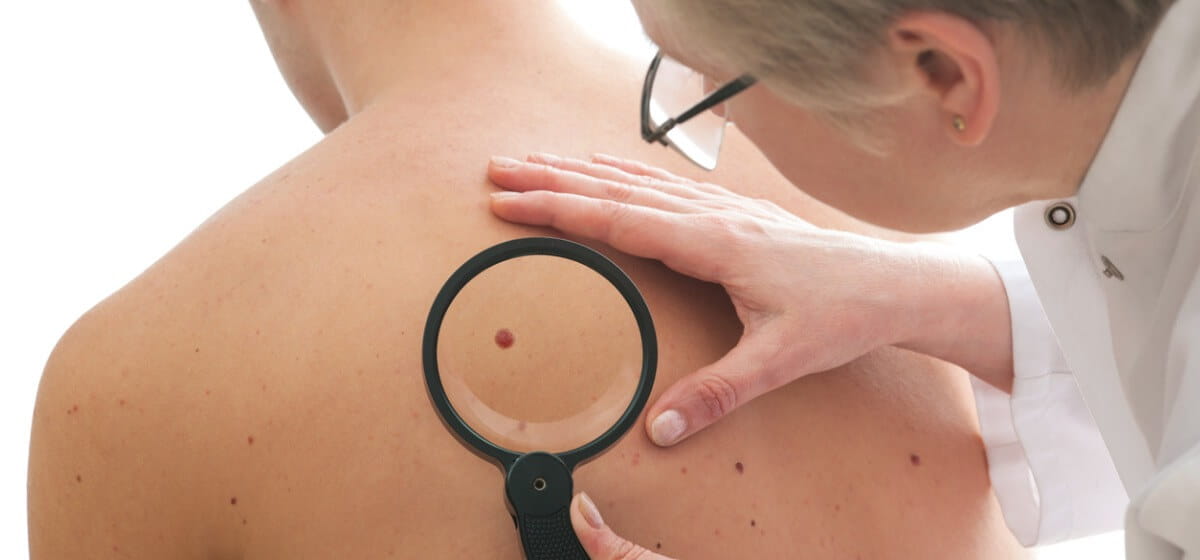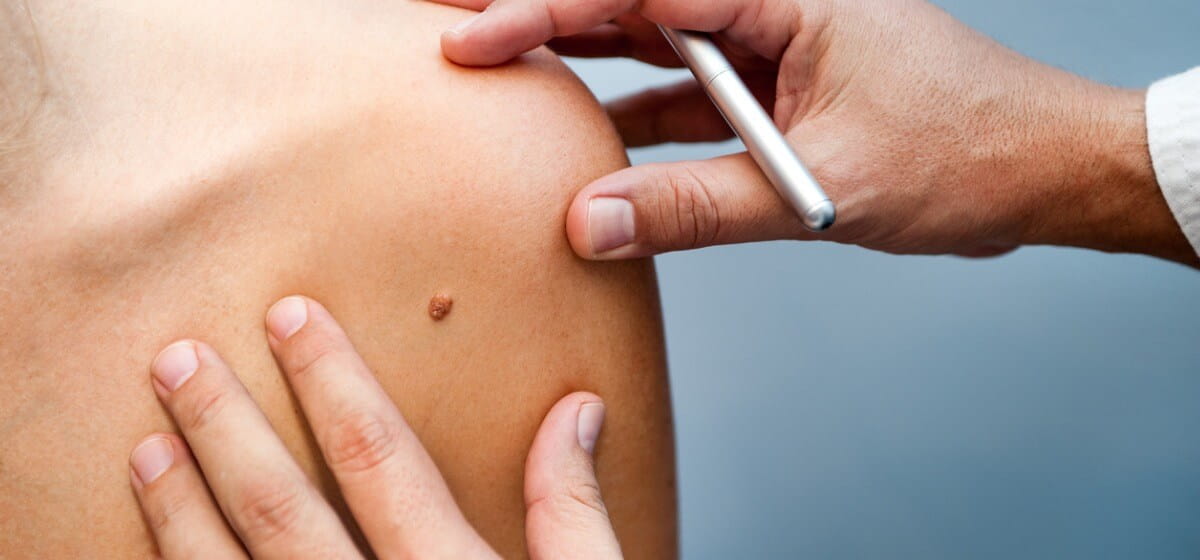What Is a Skin Cancer Screening?

Not surprisingly, all three primary forms of skin cancer — basal cell carcinoma, squamous cell carcinoma, and melanoma — have higher treatment success rates if detected early. What surprises some people is how easy it is to be screened for skin cancer. The evaluation is quick, painless, and non-invasive.
This article explains the skin cancer screening process and why getting screened regularly is so important.
Your doctor will recommend the appropriate screening frequency. If you are fair-skinned, have freckles, have light-colored eyes, spend a great deal of time in the sun, or have a personal or family history of skin cancer, you will need to be screened more often. People at high risk may need to have an assessment every three to six months.
Other skin cancer risks include:
Perform your self-exam in a well-lit room in front of a full-length mirror. You should also have a handheld mirror for viewing hard-to-see areas of your body. You might also consider asking a partner or family member to help with your exam.
Keep in mind that you should view the skin everywhere on your body, including areas that are somewhat concealed like your scalp, under your breasts, in your genital area, your buttocks, the bottoms of your feet, between your toes, etc. You will likely have to get into various positions (standing, sitting, lying down, etc.) to do a thorough exam.
As you view your skin, use the skin cancer ABCs to evaluate moles or spots. Further evaluation is appropriate if they display:
A – Asymmetry
B – Border irregularities
C – Color inconsistencies
D – Diameter larger than 6 millimeters across (the size of a pencil eraser)
E – Evolving in shape, size, or color
To get started, you’ll remove your clothes and put on a gown. The doctor will then look at every inch of the skin surface on our body, from the top of your head to the bottom of your feet, to check for skin cancer symptoms.
Your doctor uses the ABCs described above for evaluating any moles, skin color changes, etc., that they find. While it’s a thorough process, it doesn’t take long.
There, a pathologist looks at it under a microscope to see if cancer cells are present. If there are, your doctor will develop a treatment plan.
While skin cancer is common, screening is easy, and treatment can be successful, especially with early detection. If you notice a suspicious mole, don’t wait until your next scheduled cancer screening. Talk with your doctor right away.
This article explains the skin cancer screening process and why getting screened regularly is so important.
Who Should Be Screened for Skin Cancer?
People of all skin tones and races can get skin cancer, and some forms of skin cancer can spread to other areas of the body. Consequently, everyone should perform a skin cancer self-exam at least monthly and have a skin cancer screening by a healthcare professional regularly.Your doctor will recommend the appropriate screening frequency. If you are fair-skinned, have freckles, have light-colored eyes, spend a great deal of time in the sun, or have a personal or family history of skin cancer, you will need to be screened more often. People at high risk may need to have an assessment every three to six months.
Other skin cancer risks include:
- Indoor tanning
- Having many moles or large ones
- Sun damage
- Having moles that differ from one another in shape or color
- Weakened or suppressed immune system
Doing Regular Skin Cancer Self-Exams
You should do skin cancer self-exams regularly, especially if you have a higher skin cancer risk. It’s also a good idea to do for a self-exam prior to a skin cancer screening, noting anything that concerns you so you can talk with your doctor about it.Perform your self-exam in a well-lit room in front of a full-length mirror. You should also have a handheld mirror for viewing hard-to-see areas of your body. You might also consider asking a partner or family member to help with your exam.
Keep in mind that you should view the skin everywhere on your body, including areas that are somewhat concealed like your scalp, under your breasts, in your genital area, your buttocks, the bottoms of your feet, between your toes, etc. You will likely have to get into various positions (standing, sitting, lying down, etc.) to do a thorough exam.
As you view your skin, use the skin cancer ABCs to evaluate moles or spots. Further evaluation is appropriate if they display:
A – Asymmetry
B – Border irregularities
C – Color inconsistencies
D – Diameter larger than 6 millimeters across (the size of a pencil eraser)
E – Evolving in shape, size, or color
What to Expect at a Skin Cancer Screening
At your skin cancer screening, you want the doctor to have an unobstructed view of your skin. So, you should remove nail polish and makeup, have your hair loose so it’s easy to move aside, etc.To get started, you’ll remove your clothes and put on a gown. The doctor will then look at every inch of the skin surface on our body, from the top of your head to the bottom of your feet, to check for skin cancer symptoms.
Your doctor uses the ABCs described above for evaluating any moles, skin color changes, etc., that they find. While it’s a thorough process, it doesn’t take long.
Skin Cancer Biopsies
If your doctor sees any suspicious moles or spots, you may need to have a test called a biopsy. In this procedure, your doctor gives you a shot at the site to numb it. Then they scrape off as much of the mole as possible and send the material to a lab for evaluation.There, a pathologist looks at it under a microscope to see if cancer cells are present. If there are, your doctor will develop a treatment plan.
While skin cancer is common, screening is easy, and treatment can be successful, especially with early detection. If you notice a suspicious mole, don’t wait until your next scheduled cancer screening. Talk with your doctor right away.
Skin Cancer Screening Considerations
Skin cancer screening is a safe process. However, there are risks to consider, including:- False-positive results (your screening indicates you have skin cancer when you don’t)
- False-negative results (your screening suggests you don’t have skin cancer when you do)
- Stress from detected skin cancer that won’t ever cause health problems
- Stress from the discovery of advanced, untreatable skin cancer
How to Reduce Your Skin Cancer Risk
You can reduce your risk of developing skin cancer by protecting your skin from the sun’s harmful ultraviolet (UV) rays with these actions:- Minimize sun exposure between the hours of 10 a.m. and 4 p.m.
- Wear clothing that covers your skin
- Wear sunglasses
- Apply sunscreen with a sun protection factor (SPF) of 30 or higher to exposed skin
- Don’t sunbathe
- Don’t use an indoor tanning bed
Get Regular Skin Cancer Screenings from Baptist Health
Skin cancer is a serious condition that can spread to other areas of the body. However, you can catch it early by doing skin cancer self-exams and seeing your doctor regularly for skin cancer screenings.
If you develop skin cancer, Baptist Health can help. Learn about our cancer care services.



